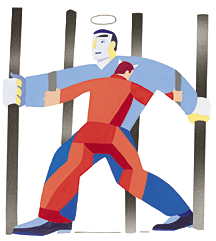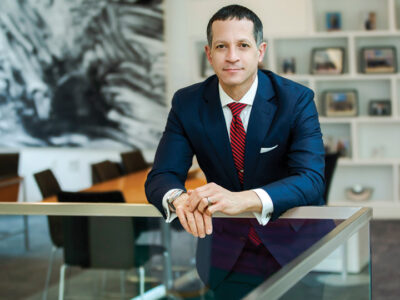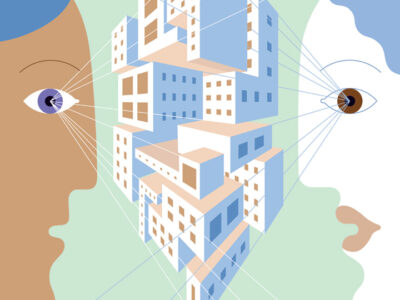On guard at Megiddo Prison.
By Gary L. Rashba

The ruins of Megiddorise up from the fertile Jezreel Valley of northern Israel. Built on the ancient thoroughfare that linked Egypt with Mesopotamia, Megiddo was a powerful center of commerce, and its many layers of civilization span nearly seven millennia.
But the city at the crossroads of cultures was also steeped in conflict. Epic battles deciding the fate of empires were fought before its walls. Today the name Megiddo—or, more precisely, Har Megiddo (Hebrew for Megiddo Mountain)—is better known by its biblical name: Armageddon. According to the New Testament’s Book of Revelation, it will be the site of the conclusive battle between the forces of good and evil.
A few hundred meters from the ruins is another, less heralded venue of a struggle between opposing forces: Megiddo Prison, an Israel Defense Forces (IDF) compound holding men at the heart of the Palestinian-Israeli conflict. The men held in its fenced-in compounds are all “security prisoners”—better known as terrorists—and during my recent tour of duty as a reservist for the IDF, I was charged with guarding them. While not first-degree murderers with blood on their hands, the nearly 1,200 men incarcerated at Megiddo Prison are mostly one notch down—the accomplices who aided and abetted in the terror that has resulted in the deaths of nearly 700 and wounding of well over 4,500 Israelis since the second intifada, or Palestinian uprising, broke out in October 2000.
It struck me as fitting that the prison is located on the site of Revelation’s showdown with evil, since as far as I was concerned, the prisoners were evil incarnate. They are the reason I have been forced to live in fear for the past two years of being in the proverbial wrong place at the wrong time—a trite expression that saves me from having to describe the horrific, all-too-familiar aftermath of a Palestinian terror attack.
At first, I found myself watching the prisoners like animals at the zoo. They paced, exercised, ate, and went about their routines, sometimes watching me just as intently as I watched them. I wanted them to look like the Hollywood image of terrorists: unshaven, with stereotypical Middle Eastern facial features and an evil way about them. But all I found were ordinary-looking men: some bearded with close-cropped hair, Islamic-style—but overall they were like any cross section of Middle Eastern men.
From guard towers perched above the camp, we kept an eye on prisoners in the fenced-in compounds, making sure no one snuck from one compound to another or tried to escape. Some of the towers were rather close in to the prison compounds, making me feel like the one in the cage. Though physically close at times, we had orders not to talk to or interact with the prisoners.
Just as the prisoners didn’t measure up to the images I had in my head, neither did the prison. There were no bright orange jumpsuits, no polished cellblocks. The prisoners wore their own T-shirts, track suits, and other comfortable clothing, with sandals or sneakers. It was certainly no stark Camp X-Ray (the U.S. Marines’ detention facility at Guantanamo Bay in Cuba, where Taliban prisoners are incarcerated)—nor anything else resembling the orderly prison image we have from television and movies. Megiddo’s prisoners live in tents, not cells, and its overall appearance is rather sloppy, with laundry and blankets hanging on fences and mattresses kept outside (perhaps to keep out prying eyes). Discipline seemed to match its appearance. The prisoners had a great deal of autonomy, and kept themselves busy watching television, playing basketball, volleyball, and ping-pong, exercising with free weights, reading newspapers, playing sheshbesh (the Middle Eastern version of backgammon), joining in group prayer, reading books from their library, and participating in lectures. They also have their own rotations, including “guard duty,” where they keep an eye on the prison guards, perhaps looking for the weak link in the chains that bind them. Messengers throw and catch “faxes”—messages attached to some weighted object and thrown from one fenced-in compound to another. They cook for themselves, bake their own flat pita bread, and do their own laundry. It seems Adam Smith’s laissez-faire economic policies have been applied to prison, with the idea that leaving the prisoners on their own means fewer headaches for the jailers. Yet it also makes it harder to keep track of things going on inside; in September, the press reported the discovery of two separate tunnels prisoners were secretly digging.
The prisoners also keep a close eye on one another to prevent snitches. Given that they represent the different and sometimes conflicting political factions among the Palestinians—including Hamas, Islamic Jihad, and Fatah—the ingredients for trouble are in place. The IDF is responsible for the prisoners’ health and well-being, and if anything happens, it can be amplified into the issue of how Israel treats prisoners and can become yet another way for the world to judge Israel.
To me the system was far too lenient on the prisoners. Some of my fellow reservists thought these men should be treated harshly. Others said no—that we must maintain our high ethical standards so that these men will see that Israelis and Jews are not subhuman, evil creatures, as they may have been told. One of the prison’s officers told us that how prisoners are treated is almost irrelevant, noting that it is a misconception that prison rehabilitates the prisoner. “No one,” he said, “will leave here regretting whatever he did that put him here.”
Discipline is maintained, the officer explained, “by making certain the prisoners always have something to lose.” One of his prime tools is cigarette purchases, which he makes on their behalf. “When the prisoners are acting up,” he told us, “I sometimes forget to buy a few hundred packs of cigarettes, and the point is well understood.”
Specially trained soldiers of the military police handle day-to-day responsibilities of the prison. As reservists, our mission was security detail. This mostly meant guarding the prison perimeter but also included guarding the prisoners up close when they were out of their locked compounds, such as carrying in food supplies or taking out the garbage.
One day I participated in one of the several daily prisoner counts, giving me an up-close glimpse at the inside—what I had previously seen only from the guard towers. Inside the tents, personal effects from home decorate their living areas. Since the men are incarcerated at Megiddo for up to five years, that is understandable. But what surprised and upset me were the pictures honoring shahidim—martyrs, as they call their suicide bombers who have blown themselves up in order to kill Israelis. That these were permitted was offensive and deplorable.
One day I served as an armed escort for a busload of men going to their trials at one of the IDF’s military courts. Prisoners get their day in court, with the venue determined by the region near their homes so that families may attend the trial and see their loved ones, and the logistics of safely transporting them to and from the prison are complicated. After the prisoner’s identities were verified, the men were handcuffed and put on a specially protected bus, which took a circuitous route to limit exposure to possible attacks or attempts to free the prisoners. Upon arrival, the prisoners were moved to holding cells and small groups were led to their trials. To allow for representation, judges accommodated requests to reschedule court dates when prisoners found someone else’s lawyer in the courtroom and hired him on the spot.
At times I caught myself falling for what must be some perversion of the “Stockholm Syndrome.” In the interactions with their jailers that I saw, all prisoners acted very subordinate. Seeing subjugated men locked in cages—sometimes even closing themselves into their cells, handcuffed, or put in cramped holding cells at the courthouse (where I saw their smiles upon seeing their families)—I started to feel almost sorry for them. Then I would remember that these are people who would undoubtedly like to kill me or any other Jew simply for being Jewish. The expended tear-gas grenades dangling from the prison fencing like Christmas ornaments testify to the fact that their behavior can change from submissive to violent in the blink of an eye. From the perimeter guard towers overlooking the road I could see pieces of charred and twisted metal—all that was left of a recent suicide bus bombing (or, more accurately, a homicide bombing) that took 16 Israeli lives. The prisoners reportedly cheered upon hearing the explosion.
Two years of violence have done nothing to further the Palestinian cause. The intifada has dashed hopes for peace and destroyed any level of trust that Israelis had in the Palestinian Authority as a partner for peace. About the only “success” it can claim is keeping Megiddo Prison—which had been slated to be closed several times—in business. Another millennium of violence is dawning at Armageddon.
Gary Rashba C’90 has lived in Israel for nine years. He works as an industrial-cooperation manager for Lockheed Martin Corporation.




